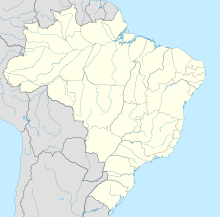Carajás Mine
 Carajás mine open pit. | |
| Location | |
|---|---|
 Carajás mine Location in Brazil | |
| State | Pará |
| Country | Brazil |
| Coordinates | 06°03′31″S 50°10′37″W / 6.05861°S 50.17694°W / -6.05861; -50.17694Coordinates: 06°03′31″S 50°10′37″W / 6.05861°S 50.17694°W / -6.05861; -50.17694 |
| Production | |
| Products | Iron ore |
| Production | 296 million metric tons of iron ore |
| Financial year | 2007 |
| History | |
| Closed | NA |
| Owner | |
| Company | Vale S.A. |
| Year of acquisition | 1995 |
The Carajás Mine is the largest iron ore mine in the world. It is located in the municipality of Parauapebas, state of Pará in the Carajás Mountains of Northern Brazil. The mine is operated as an open-pit mine, and is estimated to contain roughly 7.2 billion tons of iron ore, plus gold, manganese, bauxite, copper, and nickel.
[1] The mine is run by Vale (formerly the Companhia Vale do Rio Doce) and was previously part-owned with US Steel until 1977.
[1]
The mine is located in the mining concession area of the Carajás National Forest, which "contains known reserves of the order of 18 billion tons with an average grade of 65.4% Fe."[1]
The mine is largely powered by hydroelectric power from the Tucuruí Dam.
[2]
References
^ abc "Carajas Iron Ore Mine - Mining Technology". Retrieved 2012-04-09..mw-parser-output cite.citation{font-style:inherit}.mw-parser-output .citation q{quotes:"""""""'""'"}.mw-parser-output .citation .cs1-lock-free a{background:url("//upload.wikimedia.org/wikipedia/commons/thumb/6/65/Lock-green.svg/9px-Lock-green.svg.png")no-repeat;background-position:right .1em center}.mw-parser-output .citation .cs1-lock-limited a,.mw-parser-output .citation .cs1-lock-registration a{background:url("//upload.wikimedia.org/wikipedia/commons/thumb/d/d6/Lock-gray-alt-2.svg/9px-Lock-gray-alt-2.svg.png")no-repeat;background-position:right .1em center}.mw-parser-output .citation .cs1-lock-subscription a{background:url("//upload.wikimedia.org/wikipedia/commons/thumb/a/aa/Lock-red-alt-2.svg/9px-Lock-red-alt-2.svg.png")no-repeat;background-position:right .1em center}.mw-parser-output .cs1-subscription,.mw-parser-output .cs1-registration{color:#555}.mw-parser-output .cs1-subscription span,.mw-parser-output .cs1-registration span{border-bottom:1px dotted;cursor:help}.mw-parser-output .cs1-ws-icon a{background:url("//upload.wikimedia.org/wikipedia/commons/thumb/4/4c/Wikisource-logo.svg/12px-Wikisource-logo.svg.png")no-repeat;background-position:right .1em center}.mw-parser-output code.cs1-code{color:inherit;background:inherit;border:inherit;padding:inherit}.mw-parser-output .cs1-hidden-error{display:none;font-size:100%}.mw-parser-output .cs1-visible-error{font-size:100%}.mw-parser-output .cs1-maint{display:none;color:#33aa33;margin-left:0.3em}.mw-parser-output .cs1-subscription,.mw-parser-output .cs1-registration,.mw-parser-output .cs1-format{font-size:95%}.mw-parser-output .cs1-kern-left,.mw-parser-output .cs1-kern-wl-left{padding-left:0.2em}.mw-parser-output .cs1-kern-right,.mw-parser-output .cs1-kern-wl-right{padding-right:0.2em}
[unreliable source?]
^ "Mining Giant Joins Belo Monte Dam - International Rivers". Retrieved 2012-04-09.
This article about mining is a stub. You can help Wikipedia by expanding it. |
This Pará, Brazil location article is a stub. You can help Wikipedia by expanding it. |